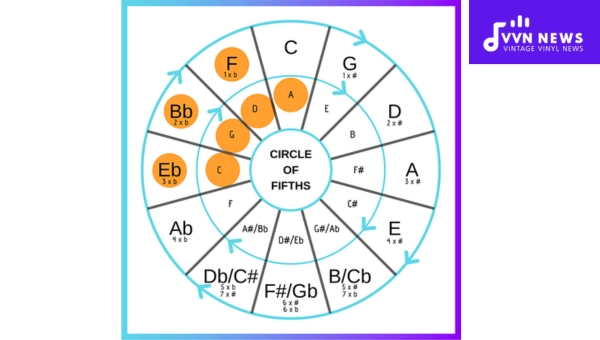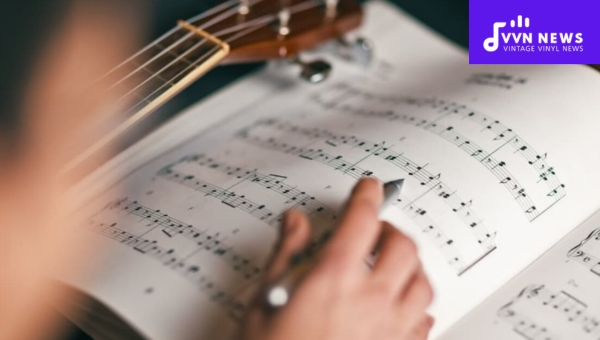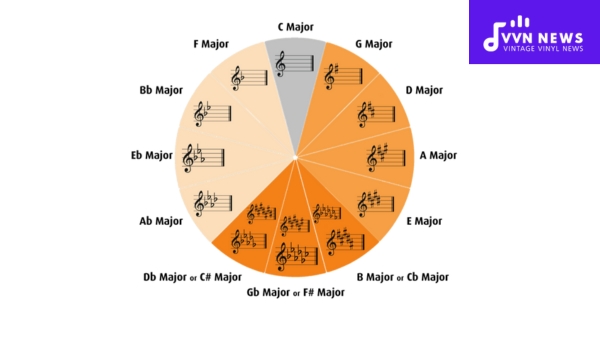When I first dipped my toes into the wide ocean of music, a bewildering array of notes, keys, and chords awaited me. However, knowing how to navigate this landscape gave me a profound appreciation for the art that is both discipline and liberation. So you ask, how to learn music theory?
Peeking under the hood of your favorite songs to reveal the engine powering them is indeed exciting. It’s like learning a new language – complex but profoundly rewarding at the same time.
As with any journey, you need an effective road map to guide you through it all.
For those aspiring musicians among us yearning to match notes with names and noises with notations, this article will aim to provide that map illuminating the pathway toward understanding basic music theory.
What is Music Theory?
Music theory is, in essence, the study of how music is written and played. It is a set of guidelines and norms that dictate how melodies, rhythms, and harmonies interact with each other to create what we know as ‘music.’

Elements of Music Theory
Melody: A sequence or progression of notes that create a pattern we recognize as a musical tune.
Harmony: Formed when multiple notes are played simultaneously. Harmonies can add depth and complexity to music.
Rhythm: Defines the beat or tempo at which notes are played. Rhythm provides the framework within which melody and harmony exist.
The Language of Music
Think of it as learning a new language. Just as different letters form words in a language, various notes form scales in music.
This organized series of pitches is foundational for understanding chord progressions, note relationships, and key signatures among others, thus becoming an essential building block for sight-reading or composition.
Simply put, learning music theory is like obtaining the ‘how’ and ‘why’ behind all our favorite songs, an indispensable companion to appreciate music dynamics completely!
This knowledge isn’t essential to enjoying music, but it indeed deepens our understanding – encouraging us to explore more complex compositions with confidence.
Also Read: Discover the Most Popular Chord Progressions in Music
the Advantages of Learning Music Theory
As you venture into music theory, it can be heartening to know how much this knowledge can benefit your musical journey.
Let’s delve into some key advantages:
Enhances Sight Reading and Composition Skills
By understanding music theory, you can read sheet music more easily and proficiently, enabling you to play pieces faster and more accurately.
This comprehension paves the way for communicating your ideas better musically, whether that lies in tweaking a favorite piece or composing an original melody.
Unlocks Deeper Musical Understanding
With a solid grip on music theory, you break down complex pieces into their fundamental elements: pitches, rhythms, and harmonies.
Isolating these components allows us to gain a deeper appreciation for the artistry of constructing these pieces – from pop to symphony masterpieces!
Boosts Creativity and Improvisation
Familiarity with scales, chord progressions, or key signatures provides a structured framework within which our creativity can take flight.
It helps to improvise on a whim and play around with variations within known constructs.
Facilitates Better Communication
Imagine being able to articulate what precisely about certain songs stirs emotions in you. Or pin-pointing what sounds ‘off’ in an arrangement?
Mastering music theory empowers us with terminology and concepts, enabling more transparent dialogue with other musicians or even non-musicians!
By embracing this beautiful language of music theory, we unlock doors that lead towards enhanced comprehension, increased creative control over our compositions and improvisations, and ultimately, the ability to appreciate something we love at an even deeper level.
Also Read: Understanding Music Transposition: A Complete Guide
Understanding the basics of Music
As with every journey, the first step is to decide and commit to studying music theory. As this can sometimes feel like an advanced concept, it would be prudent to maintain a positive attitude and patience toward gradual progress while in this study.

One can start by procuring a music theory book or signing up for an online course.
These mediums provide comprehensive guides encompassing vital elements of music theory – from notation, rhythm understanding, and scale construction up to harmonic analysis.
Furthermore, familiarize yourself with musical symbols and terminologies as these serve as vital tools in comprehending sheet music or theoretical lessons later.
Rudiments
Known as the foundational principles that form musical basics are rudiments, including basics of rhythm (measuring beats and blank spaces), melody (high vs low notes), and harmony (two or more simultaneous notes).
Notation
The notation or musical notes sketches a map for musicians, giving them direction on what note to play, how long to hold it, etc.
Capitalizing on our knowledge of rudiments, we can identify staff lines, note values (such as quarter notes and half notes), rests, along with time signatures, among others.
Chords
A chord signifies multiple notes played simultaneously, producing a single sound that varies from mellow to dramatic based on chord structure.
Recognizing chord structures yields insight into how they’re constructed, leading us toward realizing chords by ear.
Major chords (happy sounding) and minor chords (sad or dramatic sounding) are two basic types under this category that we could start with.
Scales
A fundamental aspect of music theory is understanding scales, which are ordered sequences of notes grouped together due to their harmonic compatibility.
There are various types – Major scales (‘doe-ray-me’), and minor scales, among others, being the most prominent ones.
They later provide a framework for constructing melodies or figuring out keys, which we will look at next.
Keys
Every piece of music is written in a specific key, determining what sharps, flats, or natural must be included in a song’s score and defining its character throughout the piece.
For instance – Pieces in primary keys evoke happy/joyful feelings, whereas those in minors evoke sorrowful/pensive emotions.
Root note affirms what key you’re playing—thus solidifying our understanding of various pieces’ tonality aspects.
Rhythm
Understanding rhythm develops your innate sense of beat and time, which drives every piece forward.
Learn about elements such as downbeat, upbeats, and timing signatures that tell us ‘how many beats?’ & ‘Which type of beat lasts one measure?’ lie within frames.
Theory Exercises
Frequent practice rounds form an essential part of reinforcing all theories learned.
Some websites offer a myriad of exercises focusing on different elements that can refine your understanding over time.
The key here lies in consistency! Regular practice sessions allow us to grasp concepts better over time.
How To Learn Music Theory?
To start learning music theory, begin by mastering the basics – understand the staff, clefs, and notes. Get to know the major and minor scales and learn how chords are built from these scales. Get familiar with key signatures and the circle of fifths.
Try reading sheet music, which helps in understanding melody, harmony, rhythm, form, and structure in a piece.
Invest in textbooks or online resources for self-study, or consider enrolling in a music theory class or hiring a private tutor to guide you. Here’s how you can kick-start this insightful voyage:
Begin with the Basics
Start by gaining familiarization with the elemental constituents of music; this includes pitches, notes, and scales.
Pitches: Refers to how high or low a sound is.
Notes: Represents specific pitches.
Scales: A group of notes ordered by pitch.
Progress to Reading Sheet Music
Reading sheet music is akin to learning a new alphabet. There are two main components you need to understand:
- The Staff: Comprising five lines and four spaces in between, every line or space represents a different note.
- Clefs: At the beginning of each staff is a symbol defining the pitch range – Treble Clef (higher pitches) and Bass Clef (lower slopes).
Understand Key Signatures
Key signatures offer vital information on what scale a piece of music is written.
They are represented by sharps and flats placed immediately after the clef at the start of a musical staff.
Grasp Time Signatures
Learning about time signatures will steer you through understanding ‘how’ to play these notes. These symbols tell you how many beats are in each measure.
Learn Note Values
To truly understand rhythm, you need to familiarize yourself with different note values: whole notes, half notes, quarter notes – each dictating a specific length of time for which a note should be held.
Comprehend Chords
Chords are multiple notes played together, forming the harmony of music.
Basic chords include major and minor chords, but progressing further introduces you to various complex versions, such as diminished or augmented chords.
Delve Into Chord Progression
Chord progressions create a sense of movement in music. They are integral for understanding how songs are structured and created.
Branch Out to Advanced Topics
Once you’re comfortable with the basics and have a strong foundation, feel free to venture into more advanced topics within music theory, such as modes, inversions, and modulation.
Equipped with these steps, consistency is vital in this journey.
Music theory is not something you can master overnight—patience, practice, and perseverance will steadily propel your progression in this language of music.
Take the time to explore these resources and see what works best for you. Keep in mind that your journey into music theory is unique to you.
Also Read: Harmony In Music [Enhance Your Compositions With These Tips]
Resources and Tools for Enhanced Learning of Music Theory
In this digital era, you’re spoilt for choice when searching out tools and resources designed to support your exploration into the realm of music theory.

A multitude of websites, apps, and books make accessing material customized for all learning speeds, styles, and musical genres easier than ever.
Online Resources
A wealth of knowledge is available online – often without any cost associated.
Teoria is a comprehensive reference site offering interactive exercises and thorough explanations of musical concepts.
It allows you to read about a concept – and then immediately practice it.
MusicTheory.net provides excellent beginner-friendly resources, including interactive lessons on topics such as note reading, scales, or chord identification.
Be sure to check out their exercises and mobile apps, too.
Mobile Apps
Apps can turn your smartphone or tablet into convenient pocket-sized tutors.
Yousician: This gamified app makes learning music theory fun! Both free and premium versions are available based on your needs.
Perfect Ear: This app provides ear training alongside music theory lessons, making your auditory learning journey more fun and interactive.
Print Resources
For some learners, the old-school route of books remains effective!
Tonal Harmony by Stefan Kostka: This is a comprehensive guide packed with clear explanations and helpful exercises. Although dense in some parts, it is an excellent resource for intermediate or advanced learners.
The Study of Orchestration by Samuel Adler: A gem for understanding orchestration details that often go unnoticed but play a key role in defining music pieces.
From spoon-feeding newbie-friendly introductions to deep-dive exploratory materials, resources are tailored to each learner’s unique journey.
Also Read: 13 Best Power Conditioners For Superior Protection [Buying Guide]
FAQs
Where do I start when learning music theory?
Start by understanding note names, scales, and chords. Learning to read sheet music will also give you a solid foundation. You can use online resources or take a course.
Can music theory be self-taught?
Yes, absolutely. There are plenty of online resources and books available for self-study in music theory. It’s helpful to have an instrument to practice on as well.
What is the first thing to learn in music theory?
The first thing to learn in music theory is understanding musical notes and rhythms. This includes knowing the names of the notes and how they relate to each other.
How can I learn music theory quickly?
You can make learning music theory easier by using online tutorials, practicing regularly, breaking down complex concepts into manageable parts, and applying what you learn on an instrument.
What are the 7 elements of music?
The seven elements of music include melody, rhythm, harmony, dynamics, timbre, texture and form. Understanding these essential components can deepen your appreciation and knowledge of music.
Conclusion
Delving into music theory is undoubtedly worthwhile for anyone invested in music. It’s fascinating how it can significantly enrich our understanding and execution of music.
Remember that true mastery requires time, commitment, practical strategies, and resource utilization. But trust me, it’s a rewarding pathway!








